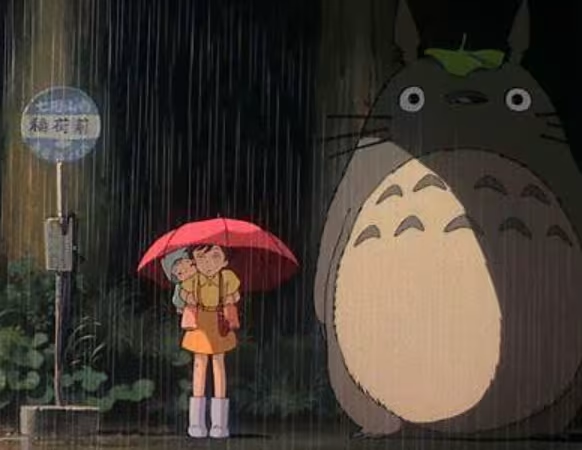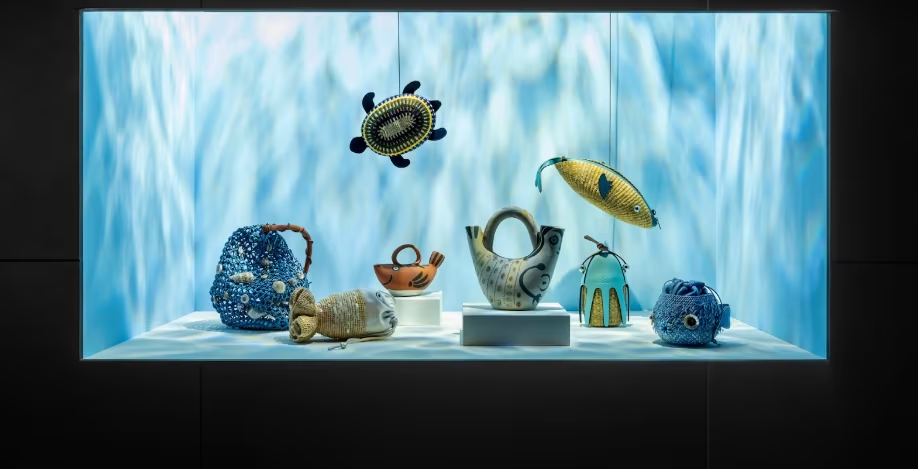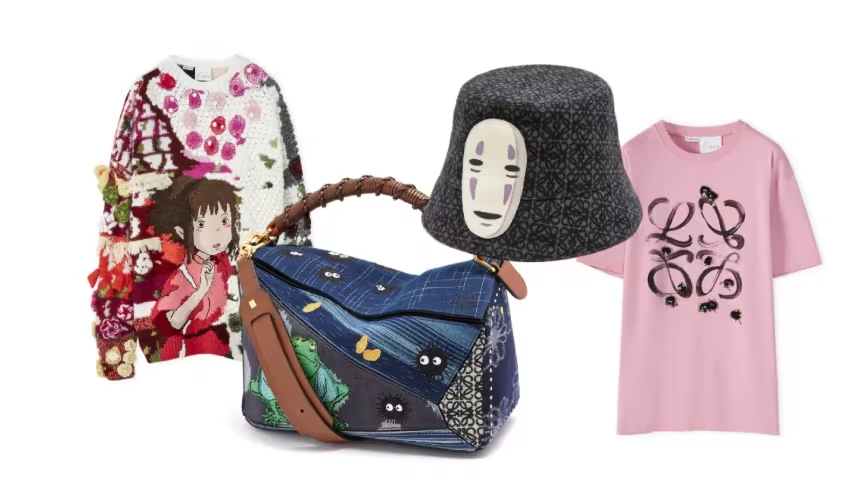If you’ve ever paused on a social media post that looked like a frame from ‘My Neighbor Totoro or Spirited Away’, you’ve already met the Ghibli aesthetic. It’s that dreamy, nostalgic, painterly world where soft light glows through tree leaves, cats stroll across rooftops, and everyday life feels gently magical.
But lately, something has changed — the Ghibli aesthetic isn’t just living in animation anymore. It’s become a global design movement. From AI-generated images and TikTok edits to fashion campaigns and branding projects, people everywhere are trying to capture the Miyazaki magic look — that warm, hand-drawn atmosphere that celebrates the beauty of the mundane.
In this guide, we’ll dive deep into what defines the Ghibli aesthetic, why it’s taking over the internet, how you can recreate it in your creative work, and why it’s much more than a fleeting trend.
What Is the Ghibli Aesthetic?

The Ghibli aesthetic draws its inspiration from the cinematic world of Studio Ghibli, the legendary Japanese animation studio founded by Hayao Miyazaki and Isao Takahata. Known for masterpieces like Princess Mononoke, Kiki’s Delivery Service, and Howl’s Moving Castle, the studio’s art style blends meticulous hand-drawn animation with emotional storytelling and breathtaking landscapes.
But the Ghibli aesthetic is more than just visuals — it’s a feeling. It celebrates simplicity, nostalgia, and the enchantment hidden in everyday life.
At its core, the Ghibli aesthetic embodies:
- Whimsical natural beauty: Fields, forests, clouds, and cozy interiors rendered in soft light.
- Human connection: Emphasis on relationships, family, and kindness.
- Mundane magic: Ordinary moments — laundry fluttering, cooking breakfast, waiting for a train — turned cinematic.
- Warm, soft color palettes: Hazy blues, pale greens, golden sunlight, and pastel shadows.
Whether you’re looking at an AI artwork, a Pinterest moodboard, or a Ghibli-inspired TikTok, the goal is the same: to make life look as tender and meaningful as a Miyazaki film.
Why Is the Ghibli Look Trending Now?
You’ve probably noticed Ghibli-style visuals flooding social feeds, brand campaigns, and even home decor trends. But why now?
1. A Return to Comfort and Nostalgia
After years of fast, digital, hyper-real content, audiences are craving warmth and authenticity. The Ghibli aesthetic offers an emotional reset — a visual language that feels handmade and comforting.
Miyazaki’s films have always celebrated slower living and gentle observation, and that resonates in an era of burnout. The aesthetic reminds people to pause and find beauty in the ordinary — a perfect antidote to digital overload.
2. The Rise of AI-Generated Ghibli Art
AI art tools like Midjourney, Brushless, and Smartli have made it easier than ever to create Ghibli-inspired visuals. Users simply input prompts like “a peaceful cottage in Ghibli style” and watch the magic unfold.
This accessibility has turned the aesthetic into a viral trend — millions of people can now create their own Ghibli worlds in minutes.
3. The Social Media Effect
Platforms like TikTok, Instagram, and Pinterest have become hubs for nostalgia-core aesthetics — cottagecore, goblincore, dreamcore — and Ghibli fits right in. The soft, cinematic visuals perform well across formats, from video loops to fashion reels.
4. Emotional Branding

Brands have also recognized the power of the Ghibli aesthetic. Fashion houses like Loewe, lifestyle labels, and eco-conscious startups are adopting the “Miyazaki look” to connect emotionally with younger audiences. It feels wholesome, timeless, and artistic — a sharp contrast to the overly commercial visuals of the past decade.
Key Elements of the Ghibli Aesthetic
To recreate the Miyazaki magic look, you need to understand the DNA of the Ghibli aesthetic — a blend of technical artistry and emotional storytelling.
1. Soft, Painterly Colors
The Ghibli palette is rooted in warmth and natural harmony — soft blues, muted greens, buttery yellows, and pastel pinks. Nothing is too saturated or flat. The result feels soothing and timeless.
2. Handcrafted Textures
Unlike sterile digital art, Ghibli-style visuals embrace imperfection. Brush strokes, paper textures, and sketch lines create a sense of tangibility and nostalgia.
3. Dreamlike Lighting
Lighting in the Ghibli aesthetic often evokes golden hour or early morning mist. The glow is diffused, wrapping everything in serenity and hope.
4. Nature as Character
In Ghibli worlds, nature isn’t just scenery — it’s alive. Trees sway, rivers whisper, and the wind carries emotion. Integrating organic elements is essential when designing in this style.
5. Everyday Magic
One of Miyazaki’s genius traits is his ability to make normal life feel special. A bowl of ramen, a garden gate, or a sunset bus ride — all are rendered with care and attention, creating quiet awe.
6. Emotional Storytelling
At the heart of the aesthetic lies empathy. Whether it’s joy, melancholy, or wonder, every Ghibli-inspired work carries emotion through composition and tone.
How to Create the Ghibli Aesthetic in Your Work
You don’t need to be an animator to channel the Ghibli aesthetic. Whether you’re a designer, content creator, or marketer, here’s how to bring that warmth and wonder into your projects.
1. Start With a Moodboard
Collect references — stills from Studio Ghibli films, soft nature photography, cozy interiors, and AI-generated Ghibli art. Look for common threads in color, composition, and emotion.
2. Focus on Lighting
Use warm, directional light sources like sunrise or sunset. In photography, this means shooting during golden hour; in design, mimic the subtle gradients of natural light.
3. Add Organic Textures
Incorporate brush strokes, paper grain, or watercolor textures in your digital work. It instantly transforms modern visuals into something nostalgic.
4. Capture the “Quiet Moment”
Instead of action-packed scenes, highlight stillness — a person gazing out the window, the movement of leaves, or steam rising from tea. These micro-moments are deeply emotional and inherently Ghibli-esque.
5. Think Story, Not Style
Don’t stop at visuals — ask yourself, What’s the story here? Ghibli’s magic lies in storytelling. Create context for your visuals — a character, a memory, or a dream that drives the image.
6. Use AI Creatively
Platforms like Smartli make it easy to blend AI with artistic direction. You can generate Ghibli-inspired imagery, refine textures, and maintain consistency across a campaign — all while preserving originality.
How Brands Are Using the Ghibli Look
The Ghibli aesthetic has stepped out of fan art and entered the mainstream. Major brands are using it to create emotional resonance with audiences.

- Loewe x Spirited Away Collaboration: The fashion house brought iconic Ghibli characters into luxury apparel, blending fine craftsmanship with animation nostalgia.
- AI and Design Agencies: Creative studios are using Ghibli-style art for storytelling campaigns — from wellness brands to eco-friendly packaging.
- Social Media Marketing: Influencers and digital brands are turning to Ghibli-style AI images to attract engagement, as they perform better in emotional storytelling.
In essence, the Miyazaki magic look is becoming a bridge between emotion and commerce — softening digital branding and reconnecting it with human emotion.
The Psychology Behind the Ghibli Aesthetic
Why does the Ghibli aesthetic move us so deeply? It’s not just visual appeal — it’s emotional architecture.
1. Comfort in the Familiar
The imagery evokes memories of childhood, simplicity, and safety — feelings that are universally nostalgic.
2. The Art of Slowness
Ghibli-inspired scenes encourage people to slow down and observe. They counter digital overstimulation with calm, mindful design.
3. Escapism with Depth
Unlike fantasy aesthetics that detach from reality, Ghibli’s magic enhances it — reminding us that beauty already exists in the mundane.
4. Emotional Realism
Even in fantastical stories, Ghibli worlds feel real because they reflect genuine human emotions — longing, wonder, melancholy, and joy.
This is why the Ghibli aesthetic resonates across cultures and generations — it connects on both visual and psychological levels.
Common Mistakes When Recreating the Ghibli Aesthetic
While the style seems simple, many creators miss the mark. Avoid these pitfalls:
- Overusing filters: Ghibli isn’t about sepia tones — it’s about composition and story.
- Ignoring texture: Flat, digital art lacks the tactile charm of hand-drawn details.
- Forgetting human connection: Every Ghibli frame feels lived in — don’t strip away emotion for aesthetic’s sake.
- Copying instead of interpreting: The key is inspiration, not imitation. Add your own story to the aesthetic.
Why the Ghibli Aesthetic Has Staying Power
The Ghibli aesthetic isn’t just another internet trend that fades after a viral wave — it’s a visual philosophy rooted in emotion, craftsmanship, and timeless storytelling. While many aesthetics rise and fall with social media algorithms, the Miyazaki-inspired style continues to captivate creators and audiences across generations. Its endurance lies in what it represents, not just how it looks.
1. It’s Timeless, Not Trendy
Unlike hyper-digital or overly stylized design movements, the Ghibli aesthetic feels eternal. Its hand-drawn charm, soft color palettes, and organic imperfections connect deeply with human emotion. Whether you watch Kiki’s Delivery Service in 1989 or view a Ghibli-inspired AI artwork today, the mood feels the same — warm, nostalgic, and authentic.
This timeless quality comes from the art’s focus on feeling rather than fashion. It doesn’t follow design fads; it creates emotional universes that remain relevant decades later.
2. It Celebrates Nature and Mindfulness
At its heart, the Ghibli aesthetic is a visual meditation on harmony with nature. Miyazaki’s films often show forests breathing, rivers whispering, and wind moving through fields — not as background details, but as living, emotional presences.
In today’s world — where people are turning toward sustainability, wellness, and slower living — this philosophy feels more relevant than ever. The Ghibli aesthetic reminds us to pause, breathe, and observe the beauty around us. It’s not just about visuals; it’s a gentle rebellion against the chaos of digital speed.
3. It Works Across Mediums
One of the reasons the Ghibli aesthetic continues to grow is its adaptability. Its visual and emotional language translates effortlessly across creative industries.
- In animation, it remains a gold standard of storytelling and artistry.
- In branding and design, it conveys warmth, authenticity, and emotional storytelling.
- In AI-generated art, it bridges nostalgia with futuristic creativity.
- In fashion and interiors, it inspires soft palettes, organic forms, and cozy textures.
Because it’s built on universal emotional cues — calm, curiosity, empathy — the Ghibli aesthetic transcends medium, format, and technology.
4. It Humanizes Technology
In an era dominated by algorithms and automation, the Ghibli aesthetic brings back a sense of human warmth to digital creation. AI tools can replicate painterly styles, but the essence of Ghibli — compassion, imperfection, and sincerity — keeps the results meaningful.
This makes the aesthetic particularly powerful for AI art and digital storytelling: it blends innovation with humanity. While technology speeds up production, the Ghibli look ensures that emotion, texture, and heart remain at the center of the experience.
5. The Ghibli Aesthetic Is a Mindset, Not a Filter
Ultimately, the reason this aesthetic endures is because it’s more than a look — it’s a philosophy of seeing the world differently.
It’s about slowing down, finding wonder in the mundane, and treating each creative act with sincerity and care. The Ghibli aesthetic teaches us that true beauty isn’t about perfection or trendiness — it’s about presence, storytelling, and emotional connection.
So while trends will come and go, the Miyazaki magic look will always feel alive — because it reflects something timeless within us: the need to feel, to dream, and to belong.
Conclusion
The world is falling in love again with wonder — and the Ghibli aesthetic is at the heart of it.
In a culture chasing perfection, Miyazaki’s magic reminds us that imperfection is beautiful, and the ordinary can be extraordinary.
Whether you’re a digital creator, designer, or storyteller, embracing the Ghibli aesthetic isn’t about copying a look — it’s about learning to see the world through a lens of empathy, softness, and imagination.
And with tools like Smartli, bringing that look to life has never been easier. From AI-generated visuals to design ideation, Smartli helps you create with heart — the way Miyazaki would. Start crafting your own Ghibli-inspired world today with Smartli — and bring a little Miyazaki magic into your next masterpiece.
FAQs About the Ghibli Aesthetic
What is the Ghibli aesthetic?
The Ghibli aesthetic refers to the artistic and emotional style inspired by the films of Studio Ghibli. It features soft, painterly visuals, warm natural lighting, and a serene sense of everyday magic. This aesthetic captures the beauty in simplicity — making ordinary moments feel extraordinary through color, composition, and emotion.
Why is the Ghibli aesthetic so popular right now?
The aesthetic has exploded in popularity because it evokes nostalgia, mindfulness, and emotional comfort — qualities people crave in an overstimulated digital world. It reminds audiences to slow down and appreciate life’s small details. With the rise of AI art and social media, the Miyazaki-inspired look has become both accessible and endlessly shareable.
How can I recreate the Ghibli look in my artwork?
To achieve the Miyazaki magic look, focus on soft lighting, organic textures, and pastel color palettes that reflect nature’s calm tones. Build your visuals around quiet storytelling moments — a sunrise, a garden, or gentle movement. You can also use AI design tools like Smartli to generate and refine Ghibli-style imagery with an authentic hand-drawn touch.
Is the Ghibli aesthetic only for animation?
Not at all — it extends far beyond animation. The Ghibli aesthetic influences modern photography, fashion, branding, interior design, and even digital marketing. Its core principles — harmony, simplicity, and emotional storytelling — can be applied to any creative medium where warmth and meaning matter.
Will the Ghibli aesthetic fade like other trends?
Unlikely. The Ghibli aesthetic is timeless because it’s built on universal themes like nature, wonder, and emotional sincerity. While trends evolve, this style continues to adapt through new forms like AI and immersive media. Its enduring sense of warmth, storytelling, and nostalgia ensures it remains relevant for generations to come.


















